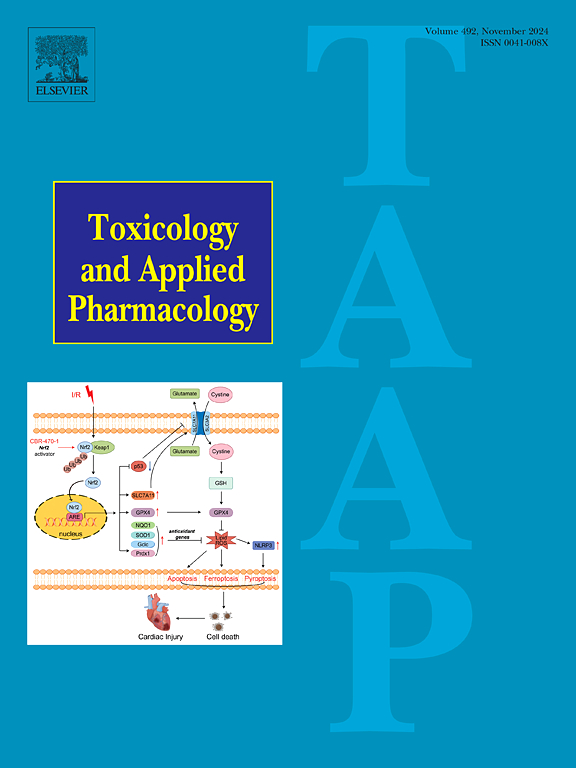Vitamin D alleviates silica-induced pulmonary fibrosis partly by inhibiting STAT3/hexokinase 2-mediated fibroblast glycolysis
IF 3.3
3区 医学
Q2 PHARMACOLOGY & PHARMACY
引用次数: 0
Abstract
Pulmonary fibrosis is defined by the excessive accumulation of extracellular matrix proteins, with few treatment options currently available. Notably, emerging evidence indicates that vitamin D may provide benefits for fibrotic lesions across various tissues. However, the underlying molecular mechanisms have not yet been fully elucidated. In our study, we observed that glycolysis levels increased during the fibroblast-to-myofibroblast transition (FMT) in both MRC-5 cells and mouse primary lung fibroblasts, however, vitamin D treatment inhibited fibroblasts' activation, proliferation, and glycolysis in vitro. We further identified signal transducer and activator of transcription 3 (STAT3) as a crucial downstream effector of vitamin D, with the expression of phosphorylated STAT3 (p-STAT3) being negatively regulated by vitamin D. In MRC-5 cells and mouse primary lung fibroblasts, ectopic expression of STAT3 enhanced fibroblast activation and blocked the anti-fibrotic effects of vitamin D. Mechanistic studies revealed that vitamin D reduces p-STAT3 levels, which inhibits the expression of hexokinase-II (HK2), a key enzyme in the glycolytic pathway, consequently blocking fibroblast glycolysis and activation. In vivo experiments demonstrated that vitamin D administration significantly mitigated silica-induced fibrogenesis, while a deficiency in vitamin D exacerbated the progression of pulmonary fibrosis. Collectively, our findings suggest that vitamin D alleviates silica-induced pulmonary fibrosis by inhibiting fibroblast glycolysis in a STAT3/HK2-dependent manner, indicating that vitamin D supplementation may serve as a promising antifibrotic agent.
维生素D部分通过抑制STAT3/己糖激酶2介导的成纤维细胞糖酵解来减轻二氧化硅诱导的肺纤维化
肺纤维化的定义是细胞外基质蛋白的过度积累,目前可用的治疗方案很少。值得注意的是,新出现的证据表明,维生素D可能对各种组织的纤维化病变有益。然而,潜在的分子机制尚未完全阐明。在我们的研究中,我们观察到MRC-5细胞和小鼠原代肺成纤维细胞在成纤维细胞向肌成纤维细胞转化(FMT)过程中糖酵解水平升高,然而,维生素D治疗抑制了成纤维细胞的激活、增殖和体外糖酵解。我们进一步确定了信号换能器和转录激活因子3 (STAT3)是维生素D的重要下游效应因子,磷酸化的STAT3 (p-STAT3)的表达受到维生素D的负调控。在MRC-5细胞和小鼠原代肺成纤维细胞中,STAT3的异位表达增强了成纤维细胞的激活,阻断了维生素D的抗纤维化作用。抑制糖酵解途径中的关键酶己糖激酶ii (HK2)的表达,从而阻断成纤维细胞的糖酵解和激活。体内实验表明,维生素D可以显著减轻二氧化硅诱导的纤维形成,而维生素D缺乏则会加剧肺纤维化的进展。总之,我们的研究结果表明,维生素D通过以STAT3/ hk2依赖的方式抑制成纤维细胞糖酵解来减轻二氧化硅诱导的肺纤维化,表明维生素D补充剂可能作为一种有前景的抗纤维化药物。
本文章由计算机程序翻译,如有差异,请以英文原文为准。
求助全文
约1分钟内获得全文
求助全文
来源期刊
CiteScore
6.80
自引率
2.60%
发文量
309
审稿时长
32 days
期刊介绍:
Toxicology and Applied Pharmacology publishes original scientific research of relevance to animals or humans pertaining to the action of chemicals, drugs, or chemically-defined natural products.
Regular articles address mechanistic approaches to physiological, pharmacologic, biochemical, cellular, or molecular understanding of toxicologic/pathologic lesions and to methods used to describe these responses. Safety Science articles address outstanding state-of-the-art preclinical and human translational characterization of drug and chemical safety employing cutting-edge science. Highly significant Regulatory Safety Science articles will also be considered in this category. Papers concerned with alternatives to the use of experimental animals are encouraged.
Short articles report on high impact studies of broad interest to readers of TAAP that would benefit from rapid publication. These articles should contain no more than a combined total of four figures and tables. Authors should include in their cover letter the justification for consideration of their manuscript as a short article.

 求助内容:
求助内容: 应助结果提醒方式:
应助结果提醒方式:


